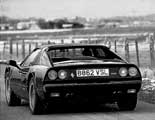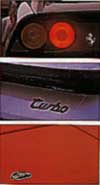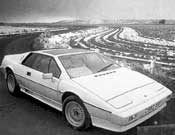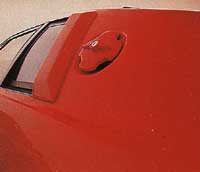
THE NEW
PERFORMANCE ELITE
With the new 944 Turbo, Porsche have
created a sensational package
with few obvious rivals in terms of performance per pound.
Kevin Buck found two, however, from Ferrari and Lotus,
to give the front-engined Porsche a real supercar challenge.
Autocar Magzine 1986
Approaching £100,000 worth of exotic supercar was drawn up around the village petrol station forecourt. 'This is my dream car,' breathed the pump attendant in undisguised excitement as she filled the fire-engine red Esprit Turbo. But what of the Ferrari GTS - arguably Modena's most enjoyable road car, or the Porsche 944 Turbo - muscular new challenger to the performance elite? She looked and thought, then dismissed them: 'Hmmm, maybe. But I've always dreamed of having one of these.'
Ferrari, Porsche, Lotus - these are certainly the stuff of dreams. But what happens when you wake up? Can reality ever compare with the imagination? We've been finding out - and discovering that while some dreams can come true, others can become nightmares.
Central to the test, of course, is the new-to-the-UK Porsche 944 Turbo, a car that is at long last a genuine, front-engined alternative to the 911. Just to make that point explicitly clear, Porsche GB prices the pair almost identically: a 911 Carrera now costs £27,497 and a 944 Turbo £27,547.
Even at this price, there is no shortage of customers and a substantial waiting list, for when you look there are, in fact, rather few alternatives. The BMW 635 and Mercedes-Benz 3805EC are probably too big, too ritzy for potential Porsche customers; the Jaguar XJS would be quick but cumbersome; the Audi Quattro lacking in status.
So, if you forgive us for leaving aside the hoary Porsche v Porsche comparison - the way is left clear for the smaller, specialist sports car manufacturers to stake a claim. That is if you can call any company 'small' when it is part of General Motors or Fiat, as now are respectively Lotus and Ferrari.
On price alone, the £23,440 Lotus Esprit Turbo merits serious consideration - a mid-engined supercar for less than the price of an XJS has to be good news. Like the Porsche, it extracts over 200bhp from four turbocharged cylinders. But any serious consideration of cars at this level of performance and prestige has to include a Ferrari, even if that means stumping up an extra £5000 to reach the bottom end of the Prancing Horse price list and the 328GTB - which costs £32,200 to be exact.
We weren't able to locate one for the test - there are few around though they were officially introduced at the end of last year, with larger engine capacity and detail changes inside and outside. Instead we settled for an immaculate, one-year-old 308GT5. Not a current model, perhaps, but on sale at Kent High Performance Cars for around £28,000 and as such an even more accessible alternative to the Porsche or Lotus. (Our thanks, incidentally, to Kent HPC who were brave enough to let us drive off in their pristine car during some of the coldest, slipperiest February weather!)
The three cars could scarcely be more different in concept and execution. The 944 Turbo builds on the new-formula Porsche theme with a host of mainly minor changes over its normally aspirated progenitor. It still has the same brawny, wide arched body, though clever spoilerwork provides a distinctive new look, and the front engine/rear transaxle, all-independently suspended chassis differs only in detail and tyre size from the lesser car.

What you get for your extra £8050 is a 40 per cent increase in power and a thumping 60 per cent increase in torque from the turbocharged engine. An all-alloy, counterbalanced four-cylinder of remarkable capacity and even more remarkable short stroke, the 2479cc unit has a KKK turbocharger, intercooling and the biggest of Bosch's black boxes to control everything through Motronic management, knock sensing and LJetronic injection.
The resulting output of 220bhp and 2431b ft of torque compare closely with the 911 (231bhp and 2101b ft).
Its mid-engined opposition have little beyond their Grand Prix inspired configurations in common. The Ferrari is built up around a spaceframe chassis and clothed in steel panels, while the Lotus, of course, uses a central spine frame and a two-piece injection moulded body. Ferrari suspension is the classic double wishbones and coils all round, while the Esprit uses Lotus's variation of that theme.
Nor do the differences stop there: the Ferrari's four-cam V8 sits crossways behind the driving compartment. It's a QV these days, meaning quattrovalvole, and as well as 32 valves also has Bosch K-Jetronic injection and Digiplex electronic ignition. The 2927cc unit of the 308 produces 240bhp and 1921b ft of torque, though the figures improve to 270 and 224 in the new 328 model. Lotus, like Porsche, rely on just half Ferrari's cylinder count. The Esprit's in-line engine is the Hethel company's familiar 2174cc, 16-valver and has a considerably different turbocharging system to that of the Porsche: the Garret T3 turbo blows through a pair of pressure-sealed Dellorto twin-choke carburettors and there is no intercooling or engine management, just wastegate boost pressure control. Maximum power is 210bhp and torque peaks at 2001b ft.
Behind the wheel

These are more than simply differences on specification sheets, they are deep seated variances of view and belief which you start to understand as soon as you open a door.
Slither down into the Lotus - and slither you most certainly will have to for the doors open barely past 45 degrees and a high sill and low, narrow footwell are obstacles to the less agile - then lie back, half reclined in the manner of a racing driver and survey the surroundings. It's a tight, enclosed little world - made even more like a goldfish bowl by the large glass sunroof in our car. Two seats nestle tightly between the sills and the huge, car-splitting centre tunnel: this is a car for pairs but not for pairing.
The arms stretched, race track driving position creates a vivid first impression. You lie low down in the car, staring out through that wide flat screen, wiped clean by a single huge pantograph wiper. Beyond the thick A-pillars, the bonnet is quite invisible. The road ahead awaits and invites.
But a few seconds acclimatisation brings the first doubts. From that low-slung seat there is little else but a view forwards; rear vision is but a slit through slats, and three-quarter rear does not exist at all.
Exiting Y-junctions demands careful use of the door mirrors and still prompts a mental crossing of the fingers. The laid back driving position has its limitations, too. The small pedals are cramped tightly into an offset footwell; don't try to drive with bulky shoes and don't expect a clutch foot rest, because there isn't one. The seat itself curls round the driver, reinforcing the support of the body members each side, but if you want to be more upright -too bad - the angle of recline is fixed.
Trimmed (at extra cost) in rumpled leather, like some opulent ad agency boardroom on wheels, the interior is a showy reminder of the Esprit's show-car origins. But surely Giugiaro never intended dull Smiths dials and clumsy Austin switches for his impressive arc of instruments - even if he wasn't too concerned about poor visibility of the lesser faces? Small but glaring reminders of Lotus's reliance on the parts bins of the corporate giants are in fact seen everywhere - flappy Marina door handles, fiddly BL locks (this is a car with as many keys as wheels!) and their presence mocks the elitist image.
Surprisingly, the Ferrari proves a marked contrast to its mid-engined contemporary. It is still low, compact, close cropped around its driver and passenger but there isn't the enveloping confinement of the Esprit's cabin. Instead the cockpit feels light and airy, and provides a much better degree of all-round vision: the disappearing curves of the front wings chart the front end's position closely and - surprise - there is a reasonable field of vision to the rear and the rear sides.



You can afford, too, a little stiffness in the joints and still slip into the leather clad seats. And there, awaiting you will be a cockpit of classic charm. Simply but tastefully trimmed in shades of leather throughout, the interior has passing faults but lasting appeal.
Not the ordered ergonomics of the Porsche or the bought-in boredom of the Lotus, but a simple hooded block of elegant Veglia dials and an array of fiddly flip switches and heater slides lying along the centre console. The driving position holds vestiges of the arms stretched, knees bent Italian tradition and headroom could be a problem for some, but the big pedals are perfectly placed in the small footwell (no space for the clutch foot again, though) and the shining chrome open gated gearchange simply demands to be used.
Alongside these two, the Porsche is quite obviously the production car among the hand built specialists. Its is an interior of machine-made mouldings and mass produced fittings - and that's no bad thing when you study the quite remarkable quality of fit and finish in the 944.
Front-engined, it is more conventional and less demanding of its driver than the mid-engined pair. You simply open the door and drop into the immaculately finished cabin from which all-round visibility is, naturally, quite the best of the three. Seats can be either leather faced or, as ours were, vinyl and cloth trimmed sports seats, whose 'sporty' side support tucks you up tightly against the Turbo's cornering forces, and which adjust electrically for rake and height. With a larger footwell, the pedals are wider spread, allowing space too for that clutch foot rest, and completing a relaxed, fault-free driving position. Instruments - new for the Turbo but shared with the latest Lux - are executed with an elegant German simplicity which Porsche shares with BMW and Mercedes-Benz, and so are the neat stalks and switches, which operate with a smooth confidence. It's an understated interior but a supremely businesslike one.
On the road
No need for delicate footwork these days on an early morning Ferrari throttle: fuel injection has brought it instant startability. Just twist the key of the 308 and you've turned a mechanical orchestra into life. There's music all around you from the first rasp of the starter to the clack-clack of the gearstick shifting through the gate.
The V8 may have silent belts rather than jangling chains to drive its camshafts, but its music is still the food of any enthusiast's passion. From a mellow blare, the engine's note rises with the revs to a howling wail as the tacho noses into the red at a stratospheric 7700rpm.
Nor is the engine howling wolf either. It delivers. And delivers with the docility of a sheep or the snarl of a tiger, as the mood takes you. Though its appetite is for revs - peak power comes at 7000rpm - there is ample torque below the 5000rpm peak and a smooth, flowing pull from down in the low reaches of the rev counter. But the fire in its belly is stoked by revs and from 5000 onwards it is scintillating.
Low gearing has been used to emphasise the 3O8's accelerative abilities: even at full crack a short straight can, effectively, put the Ferrari up into fourth or fifth holding to the cautionary 7000 orange line reduces intermediate speeds still more. The claimed 158mph maximum is right on the red line in fifth! (With its optional deeper front spoiler, our car stayed a few mph short of this figure.)
But don't confuse sound with fury; the Porsche and Lotus lack the spine tingling thrill of that multi-cylinder exhaust but they certainly don't lack raging performance In fact the two turbo-engines prove quite similar to each other in character - and quite the opposite of the Ferrari.
Where the 308, though flexible, loves revs, this pair are all about mid-range punch. That's the iron fist of both these turbocharged engines, a searing surge of speed. The Esprit, slightly lower geared than the 944, feels at first the more urgent.
There is an eagerness about its performance which demonstrates just how cleverly Lotus have speeded up the naturally lethargic responses of a turbo. The jittery fascia boost needle registers positive pressure from barely 2000rpm and confirms a surprising low-speed strength in the engine's performance as it builds smoothly into that eager mid-range where full-throttle gives biting acceleration.
Response is as sharp as a turbo-motor can achieve: push back down on the throttle after lifting off at half revs and, with an occasional hiccough, the engine will charge back and the boost needle quiver instantly round to full pressure. Do the same from a steady throttle position, as when overtaking after cruising, and there wasn't any perceptible tremor in the response.
The Porsche is more deceptively docile. There is a gentleness about its initial, part throttle response that gives no clue to its ultimate speed. Like the Lotus, there is no harsh jolt to signal the arrival of full boost: instead there is the same smooth build up of boost from below 2000rpm and the same easy-going low revs style. But when it starts to charge, rather like Steve Cram stretching his last lap stride, the build up of speed is effortless yet, ultimately, sensational.
It is the quickest of the three: a 150mph lap of Millbrook would be the match of the big-spoilered Ferrari and see off the Lotus, while in acceleration it confirms that superiority. Yet it is out on the road that this quietly confident performer is at its best: that vast reserve of torque and instant turbo response give it the relaxed power of a loping leopard.
All three cars have sufficient flexibility to reduce gear-shifting to a minimum, yet their gearboxes urge more than idle flicking between speeds. The Ferrari, in fact, positively loathes such off-hand treatment: its shift responds to firm movements and full-bore changes, otherwise the open gate will become a baulky maze. The 944 shifts quickly, sliding through the narrow gate with the precision of fine engineering, while the Esprit has a slightly stiffer, less defined change and an unpleasantly high lever mounting up on the centre tunnel to mar an otherwise quick change movement.
Alongside the mid-engined cars, the 944 Turbo has deceptively casual road manners, too. It drives as a car rather than a street-wise racer which means it hasn't quite the needle sharp reflexes a centre-mounted engine can provide. Power steering - a standard feature - and the inevitably slightly dreamy throttle response of a turbo engine conspire to make it suave rather than quick-witted in the corners.
True, the power steering is as good as they come - just a slight dullness around the centre betrays it - but the Turbo is a diplomat not a bully in its relationship with a country road. That said, there will be few cars made to go as quickly as easily. The revised chassis endows the Turbo with a nicely natured neutrality while the Dunlop D40 tyres - fat at the front and fatter still at the back - give superb traction and profound levels of grip. It will tighten its line, sometimes to the point of oversteer, if the throttle is closed mid-bend, and conventional cornering can also produce a smooth transition into power oversteer on tighter bends.
The Ferrari can also be powered into oversteer if given its head out of a tight corner but the smoothness of the slide and the ease with which it can be held and brought straight speak volumes for the chassis.
Unlike the easy natured Porsche, the 308 is a car that demands some effort from its driver. It needs to be pointed firmly and precisely into a corner, for it holds the course its driver sets, with just a modicum of understeer to provide stabilising balance. Get the line wrong, though, and an easing of the throttle will tighten the nose into the apex.
The firm, taut steering, the instantly responsive engine, the supple yet sharp chassis, make the 308 a demanding but exciting car to drive cross-country.
More exciting, arguably, than the Esprit Turbo - though it is the Lotus that has the sharpest reflexes, with quick, tight steering and an eager turn-in. At arms length, the steering can be heavy through slower corners but bicep power is less of a requirement as speed increases. On widely differing sizes of NCT front and rear, the Lotus maintains a policy of dedicated neutrality but, almost invariably, it is the front end that will drift in understeer - a lightening of the steering signalling when grip itself is starting to go.
Far more often than this, what limits the Esprit driver is a difficulty in lining up the car through corners past those obstructive A-pillars - and a certain nervousness at not being able to see who is behind!

None of the three has ABS braking -one might reasonably have expected it in the Porsche at least by now. Nevertheless, all three stop strongly; the Ferrari having a satisfying solidity to the pedal that is not quite present in its rivals. All three cars ride with a surprising suppleness; the Porsche's is exceptional, though marred by a disappointing level of bump-thump and road roar. Otherwise, it would be quiet as well as comfortable at speed. The Ferrari and the Lotus are rarely quiet but the 308's engine music proves preferable to the raucous wind roar (much of it seemingly from round the sunroof) that spoils the Esprit at speed.
Considerations of economy are perhaps of lesser importance in these cars than others, but the Porsche, again, stands out: it should usually be on the right side of 20mpg, while the Ferrari will mostly be on the wrong side of 18 and the Lotus only a little better.
Those who value their money will more likely look to the respective features lists where the Porsche boasts a panoply of standard gear from air conditioning, through electric mirrors and windows to an electric tilt or removable roof panel
The Lotus - cheaper remember - restricts its air conditioning and its roof panel to the options list and lacks central locking, too, while the Ferrari (308 and 328) has leather trim, electric this and that and central locking, with P7 tyres, air conditioning and spoilers as extras.
Summary

Frankly, this is a one car race. The Porsche is the quickest, the best built and the most economical. It's the only one that makes provision (however summarily) for carrying more than one passenger, and it can certainly carry the most luggage as well as maps and cassettes inside the car, for which there is barely room in its rivals.
It doesn't quite have the handling crispness of a mid-engined car but in return it is user-friendly to the point where your granny could drive it - she probably couldn't even get into the others!
And yet from the moment the Ferrari engine fired into life, there was only one car in it for us. The 308 is a classic; an enduring piece of engineering - the others time will pass by. Next year, perhaps, there will be an even better 944 Turbo; one day a different Esprit. But, though there is already a 328, that doesn't diminish the thrill of the 308.
Its Pininfarina styling is ten years old, but datelessly elegant; its interior confused but never confusing, and above all its performance electrifying. It's a car to savour and to cherish - and of course not to use every day. That's where it differs utterly from the Porsche.
And what of the Lotus? Caught between the devil and the deep, it is neither flawless like the Porsche nor dateless like the Ferrari. True the chassis is superb and the engine first rate, but the extrovert Giugiaro body has dated in a way Pininfarina's Ferrari can't, making its compromises to comfort and visibility less acceptable.
Yes, there is only one car. One car if you want flawless driving enjoyment and perfect practicality - the 944 Turbo - and one car if you want an unadulterated motoring experience - the Ferrari. Sadly, at the moment you can't combine the two.
|
|